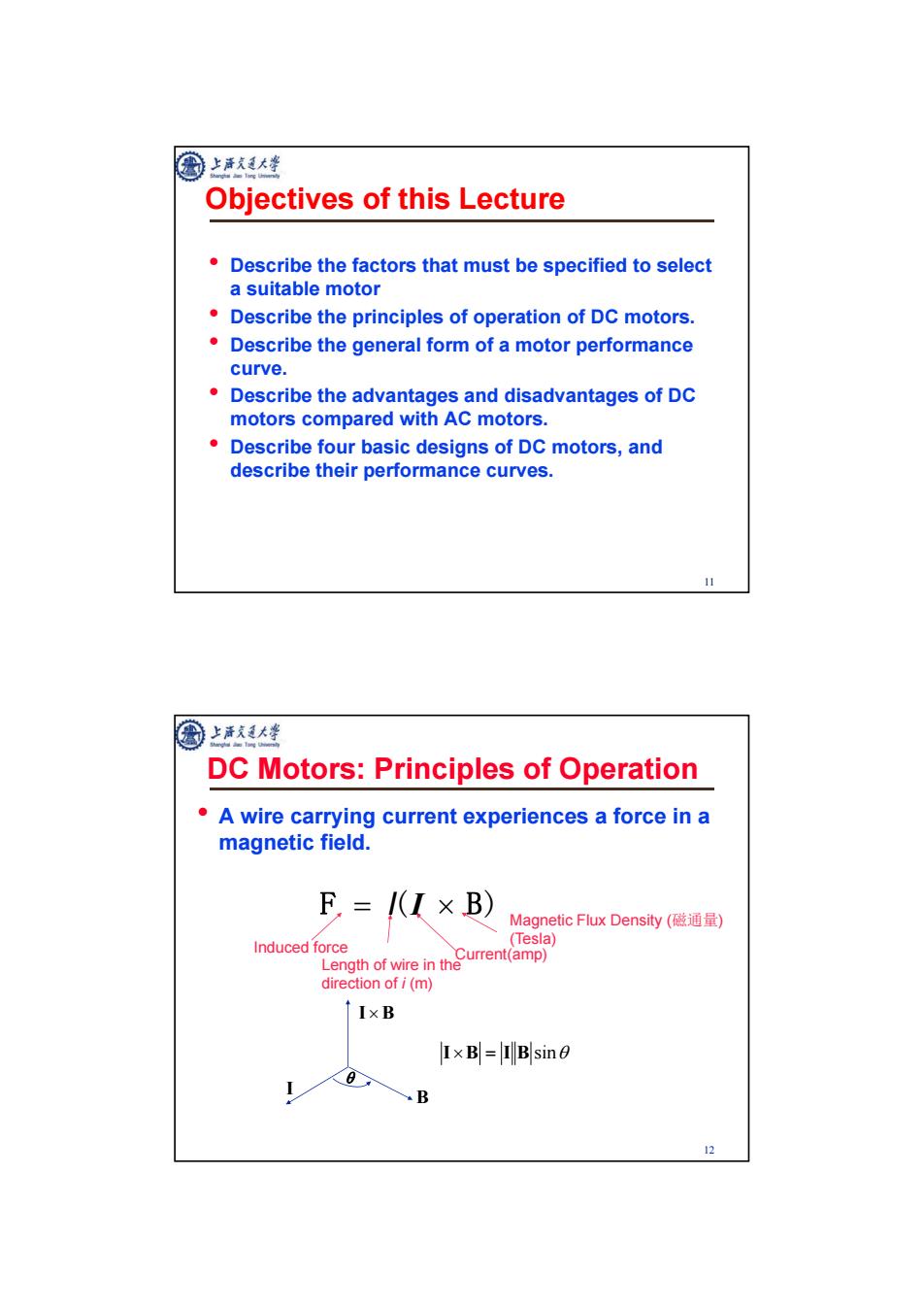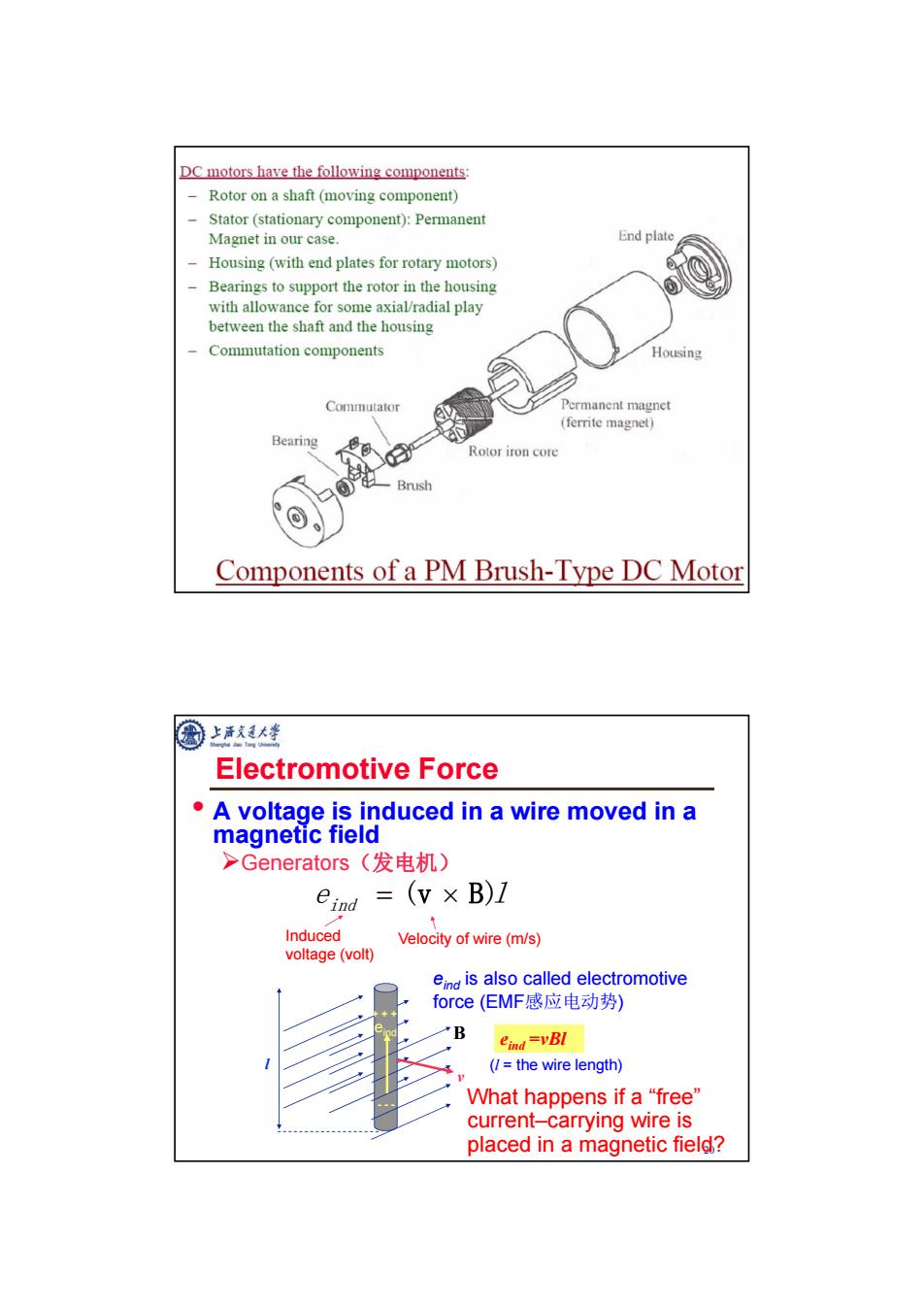
国上活廷大学 Objectives of this Lecture Describe the factors that must be specified to select a suitable motor Describe the principles of operation of DC motors. Describe the general form of a motor performance curve. Describe the advantages and disadvantages of DC motors compared with AC motors. Describe four basic designs of DC motors,and describe their performance curves. 11 国我人峰 DC Motors:Principles of Operation A wire carrying current experiences a force in a magnetic field. F= /(I×B) Magnetic Flux Density(磁通量) (Tesla) Induced force urrent(amp) Length of wire in the direction of i(m) ↑I×B IxB=IBsin B 々
11 Objectives of this Lecture • Describe the factors that must be specified to select a suitable motor • Describe the principles of operation of DC motors. • Describe the general form of a motor performance curve. • Describe the advantages and disadvantages of DC motors compared with AC motors. • Describe four basic designs of DC motors, and describe their performance curves. 12 DC Motors: Principles of Operation • A wire carrying current experiences a force in a magnetic field. Magnetic Flux Density (磁通量) (Tesla) F l(I B) Induced force Current(amp) Length of wire in the direction of i (m) I B I B IB I B sin

Electromagnetic Force A wire carrying current in a magnetic field. B F=ilB (/wire length) Note:a dot will represent a current out of the page and a cross(x)will represent a current into the page. 3 国 上清我通大学 DC Motor Operation Current runs through conductor >Armature winding(电枢绕组) Winding placed in magnetic field >Generates a force =Causes it to rotate Brushes (stationary)
13 Electromagnetic Force • A wire carrying current in a magnetic field. B i F = ilB (l = wire length) Note: a dot will represent a current out of the page and a cross() will represent a current into the page. 14 DC Motor Operation • Current runs through conductor Armature winding(电枢绕组) • Winding placed in magnetic field Generates a force =Causes it to rotate

圈上海夫廷大烽 Mechanical“Brushes” Armature Magnets coi】 Comutato (rot日l0s Brushes(电刷)and commutator(换向器)supply and switch current to armature while it rotates 15 Mechanical“Brushes” Commutation With commutation Commutation switches the direction of current every half revolution to prevent 'detention'and maintain Without commutation net positive torque Commutation is implemented via a split slip-ring and graphite 1力nw brushes Torque ripple magnitude i-coestant and frequency are a function of the number of o Ta-K,io commutation segments 12w 1r+
15 Mechanical “Brushes” Brushes(电刷) and commutator (换向器) supply and switch current to armature while it rotates 16 Mechanical “Brushes

国上活廷大姿 Brushless DC Motors Essential difference-commutation is performed electronically with controller rather than mechanically with brushes ws H * 17 国我人峰 Brushless DC Motor Commutation N N Rotor Hall effect sensor Commutation is performed electronically using a controller(e.g.HCS12 or logic circuit) Similarity with stepper motor,but with less poles Needs rotor positional closed loop feedback: hall effect sensors,back EMF,photo transistors 18 18
17 Brushless DC Motors Essential difference - commutation is performed electronically with controller rather than mechanically with brushes 18 18 Brushless DC Motor Commutation Commutation is performed electronically using a controller (e.g. HCS12 or logic circuit) Similarity with stepper motor, but with less # poles Needs rotor positional closed loop feedback: hall effect sensors, back EMF, photo transistors

DC motors have the following components: Rotor on a shaft(moving component) Stator(stationary component):Permanent Magnet in our case. End plate Housing (with end plates for rotary motors) Bearings to support the rotor in the housing with allowance for some axial/radial play between the shaft and the housing Commutation components Housing Commutator Permanent magnet (ferrite magnet) Bearing Rotor iron core Brush Components of a PM Brush-Type DC Motor 圈活大娃 Electromotive Force A voltage is induced in a wire moved in a magnetic field >Generators(发电机) eind =(v×B)1 Induced Velocity of wire(m/s) voltage (volt) eind is also called electromotive force(EMF感应电动势) B eind=vBI (/the wire length) What happens if a "free" current-carrying wire is placed in a magnetic field?
19 20 • A voltage is induced in a wire moved in a magnetic field Generators(发电机) B v (l = the wire length) Induced voltage (volt) Velocity of wire (m/s) l eind =vBl eind is also called electromotive force (EMF感应电动势) + + + --- eind What happens if a “free” current–carrying wire is placed in a magnetic field? Electromotive Force eind (v B)l